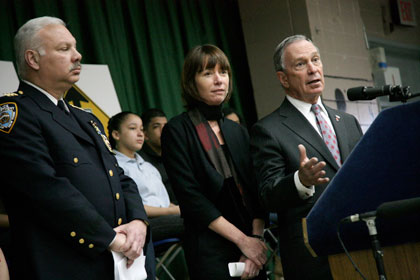With Pedestrian Deaths Up, Mayor, DOT, and NYPD Pledge Safer Streets
Pledging that "even one traffic fatality is one too many," Mayor Bloomberg joined DOT Commissioner Janette Sadik-Khan and NYPD transportation chief James Tuller today to release new information on traffic deaths in New York City. In 2009, 256 people died as a result of traffic-related injuries on city streets, a 12 percent drop from 2008 and a low figure by historical standards, but a high toll that officials vowed to drive down further.
 Tuller, Sadik-Khan, and Bloomberg at today’s announcement at PS 384. Photo: NYC.gov
Tuller, Sadik-Khan, and Bloomberg at today’s announcement at PS 384. Photo: NYC.gov"While traffic deaths are down 35 percent from 2001 levels, we have more work do to," Bloomberg said at an event held at P.S. 384 in Bushwick, "and we will continue pressing forward with better traffic engineering, stricter traffic enforcement and greater public awareness about traffic safety. Our goal is very simple: continue making our streets safer for everyone."
Breaking down the numbers reveals where much work remains to be done. Motorist fatalities declined 20 percent from the previous year, while pedestrian deaths rose slightly, from 151 in 2008 to 155 in 2009. The share of pedestrian deaths among overall fatalities grew from slightly over 52 percent in 2008 to more than 60 percent last year.
Cyclist deaths, meanwhile, dropped from 26 in 2008 to 12 last year. Although the small sample size of cyclist fatalities makes it difficult to draw hard and fast conclusions, the decline is especially notable given the greater number of cyclists on the streets — a testament to the new bike infrastructure that DOT has built recently. "One year does not make a trend," Charles Komanoff, author of Killed by Automobile [PDF], told Streetsblog, "but it does strongly suggest that
better engineering and flooding the streets with bicyclists are two big
components to making cycling much safer."
Advocates took the joint appearance by Bloomberg, Sadik-Khan, and Tuller as an encouraging sign for traffic safety as a multi-agency priority. "That the Mayor, the DOT, and the police stood up together is great," said Transportation Alternatives Deputy Director Noah Budnick, "because it shows that this is a multifaceted problem that needs coordination to be solved."
Another agency to bring on board, Budnick suggested, is the Health Department. While the yearly decline in traffic deaths is encouraging, it’s tough to determine how much of it can be attributed to different factors like street design, enforcement, or trauma care. An epidemiological approach to traffic injuries could help pinpoint what works and achieve further safety gains, Budnick said.
Other metrics in addition to traffic fatalities could offer a better picture of the state of street safety in New York. Per capita pedestrian injury rates tell perhaps the most comprehensive tale about the danger and risk people face while walking. Better information on why fatal crashes happen — which has been difficult to wrest from NYPD — would also help save lives. "We don’t have injuries, and we have zero analysis for how these pedestrians and cyclists were killed," said Komanoff. "Without the individual analyses, collectively interpreted, further progress is going to be limited."
More data may be released soon. The city announced in its press release that it will be coming out with a report showing that many fatal crashes are caused by speeding and failure to yield to pedestrians, and that DOT and NYPD will collaborate to target enforcement on these violations.
Today’s announcement included a few mentions of initiatives underway to achieve further improvements in street safety. Of particular note: DOT is looking at enhancing the safety of traffic operations near 135 elementary and middle schools, and, in a storyline to watch in Albany, legislation has been introduced to allow New York City to install speed enforcement cameras. The sponsor in the Assembly is Manhattan representative Deborah Glick.